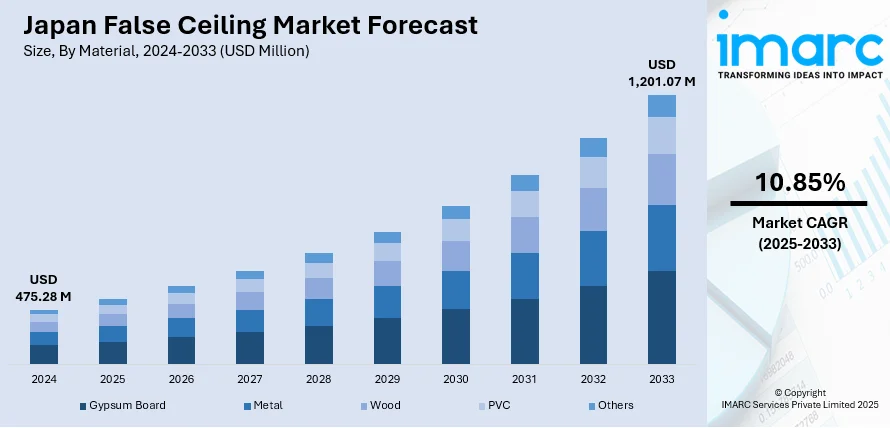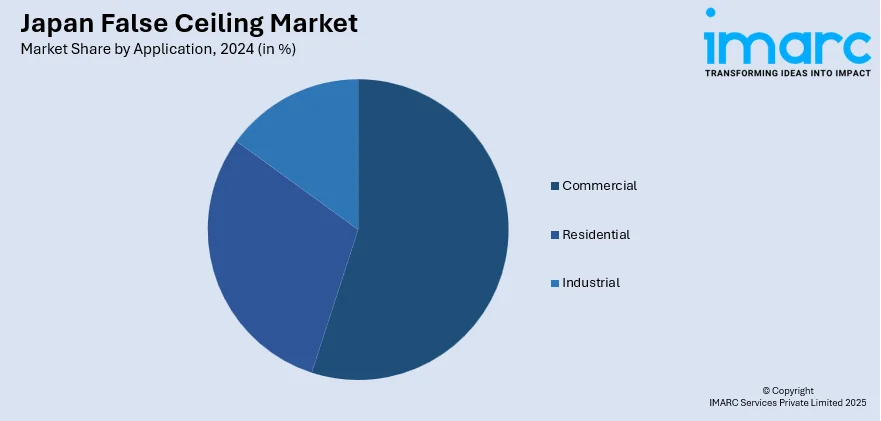
Japan False Ceiling Market Size, Share, Trends and Forecast by Material, Cost Range, Installation, Application, and Region, 2025-2033
Japan False Ceiling Market Overview:
The Japan false ceiling market size reached USD 475.28 Million in 2024. Looking forward, IMARC Group expects the market to reach USD 1,201.07 Million by 2033, exhibiting a growth rate (CAGR) of 10.85% during 2025-2033. The market is driven by stringent environmental regulations and rising demand for sustainable materials, such as recycled metal and mineral fiber, which align with Japan’s green building initiatives such as CASBEE. Additionally, the shift toward open-office layouts and smart homes is accelerating the adoption of acoustic false ceilings, integrating soundproofing and modern aesthetics. Growing urbanization, coupled with innovations in fire-resistant and energy-efficient ceiling solutions, is further augmenting the Japan false ceiling market share.
|
Report Attribute
|
Key Statistics
|
|---|---|
|
Base Year
|
2024
|
|
Forecast Years
|
2025-2033
|
|
Historical Years
|
2019-2024
|
| Market Size in 2024 | USD 475.28 Million |
| Market Forecast in 2033 | USD 1,201.07 Million |
| Market Growth Rate 2025-2033 | 10.85% |
Japan False Ceiling Market Trends:
Increasing Demand for Eco-Friendly and Sustainable False Ceiling Materials
The market is witnessing a growing preference for eco-friendly and sustainable materials, driven by stringent environmental regulations and rising consumer awareness. Builders and architects are increasingly opting for recycled metal, gypsum, and mineral fiber ceilings due to their low carbon footprint and energy-efficient properties. Additionally, materials such as bamboo and wood-based panels are gaining traction as they align with Japan’s sustainability goals. The government’s push for green building certifications, such as CASBEE (Comprehensive Assessment System for Built Environment Efficiency), further accelerates this trend. Japan's Green Transformation (GX) program, supported by a JPY 2.75 Trillion (approximately USD 19.29 Billion) Green Innovation Fund, is driving a national shift toward sustainability. This increased emphasis on clean energy and sustainable development is further evidence of the growing demand for green building materials and systems, such as false ceilings, to improve energy efficiency and environmental performance in Japan's emerging construction sector. The focus on becoming carbon-neutral by 2050 will increasingly encourage false ceiling solutions that meet stringent environmental standards and support green building activities. Manufacturers are responding by innovating with non-toxic, fire-resistant, and recyclable ceiling solutions that enhance indoor air quality while reducing environmental impact. As urbanization continues and green construction practices become mainstream, the demand for sustainable false ceilings is expected to rise significantly, shaping the future of Japan’s construction industry.

Adoption of Advanced Acoustic and Aesthetic False Ceiling Solutions
The increasing adoption of advanced acoustic and aesthetically appealing ceiling systems is supporting the Japan false ceiling market growth. With the rise of open-office layouts, co-working spaces, and smart homes, there is a growing need for noise reduction and soundproofing solutions. Perforated acoustic panels, sound-absorbing mineral fiber boards, and 3D ceiling designs are gaining popularity in commercial and residential projects. According to a research report by the IMARC Group, Japan's smart home segment is expected to grow significantly, rising from USD 8.1 billion in 2024 to USD 22.6 billion by 2033 at a CAGR of 10.80%. This growth is likely to drive the demand for smart, integrated false ceiling solutions that are equipped with smart lighting, climate control, and environmental sensors, thus opening up new opportunities for Japanese false ceiling manufacturers to innovate and capitalize on the changing needs of smart, energy-efficient homes. Additionally, customizable false ceilings with integrated LED lighting and smart ventilation systems are becoming a preferred choice for modern interiors. The demand for visually striking yet functional ceilings is further fueled by Japan’s emphasis on minimalist and futuristic architectural designs. As businesses and homeowners prioritize both functionality and aesthetics, manufacturers are expected to introduce more innovative, high-performance ceiling solutions to cater to this changing market demand.
Japan False Ceiling Market Segmentation:
IMARC Group provides an analysis of the key trends in each segment of the market, along with forecasts at the country and regional levels for 2025-2033. Our report has categorized the market based on material, cost range, installation, and application.
Material Insights:
- Gypsum Board
- Metal
- Wood
- PVC
- Others
The report has provided a detailed breakup and analysis of the market based on the material. This includes gypsum board, metal, wood, PVC, and others.
Cost Range Insights:
- Low-Cost
- Medium-Cost
- High-Cost
A detailed breakup and analysis of the market based on the cost range have also been provided in the report. This includes low-cost, medium-cost, and high-cost.
Installation Insights:
- Drywall
- Suspended
- Stretch Ceilings
- Others
The report has provided a detailed breakup and analysis of the market based on the installation. This includes drywall, suspended, stretch ceilings, and others.
Application Insights:

- Commercial
- Residential
- Industrial
A detailed breakup and analysis of the market based on the application have also been provided in the report. This includes commercial, residential, and industrial.
Regional Insights:
- Kanto Region
- Kansai/Kinki Region
- Central/ Chubu Region
- Kyushu-Okinawa Region
- Tohoku Region
- Chugoku Region
- Hokkaido Region
- Shikoku Region
The report has also provided a comprehensive analysis of all the major regional markets, which include Kanto Region, Kansai/Kinki Region, Central/ Chubu Region, Kyushu-Okinawa Region, Tohoku Region, Chugoku Region, Hokkaido Region, and Shikoku Region.
Competitive Landscape:
The market research report has also provided a comprehensive analysis of the competitive landscape. Competitive analysis such as market structure, key player positioning, top winning strategies, competitive dashboard, and company evaluation quadrant has been covered in the report. Also, detailed profiles of all major companies have been provided.
Japan False Ceiling Market Report Coverage:
| Report Features | Details |
|---|---|
| Base Year of the Analysis | 2024 |
| Historical Period | 2019-2024 |
| Forecast Period | 2025-2033 |
| Units | Million USD |
| Scope of the Report |
Exploration of Historical Trends and Market Outlook, Industry Catalysts and Challenges, Segment-Wise Historical and Future Market Assessment:
|
| Materials Covered | Gypsum Board, Metal, Wood, PVC, Others |
| Cost Ranges Covered | Low-Cost, Medium-Cost, High-Cost |
| Installations Covered | Drywall, Suspended, Stretch Ceilings, Others |
| Applications Covered | Commercial, Residential, Industrial |
| Regions Covered | Kanto Region, Kansai/Kinki Region, Central/ Chubu Region, Kyushu-Okinawa Region, Tohoku Region, Chugoku Region, Hokkaido Region, Shikoku Region |
| Customization Scope | 10% Free Customization |
| Post-Sale Analyst Support | 10-12 Weeks |
| Delivery Format | PDF and Excel through Email (We can also provide the editable version of the report in PPT/Word format on special request) |
Key Questions Answered in This Report:
- How has the Japan false ceiling market performed so far and how will it perform in the coming years?
- What is the breakup of the Japan false ceiling market on the basis of material?
- What is the breakup of the Japan false ceiling market on the basis of cost range?
- What is the breakup of the Japan false ceiling market on the basis of installation?
- What is the breakup of the Japan false ceiling market on the basis of application?
- What is the breakup of the Japan false ceiling market on the basis of region?
- What are the various stages in the value chain of the Japan false ceiling market?
- What are the key driving factors and challenges in the Japan false ceiling market?
- What is the structure of the Japan false ceiling market and who are the key players?
- What is the degree of competition in the Japan false ceiling market?
Key Benefits for Stakeholders:
- IMARC’s industry report offers a comprehensive quantitative analysis of various market segments, historical and current market trends, market forecasts, and dynamics of the Japan false ceiling market from 2019-2033.
- The research report provides the latest information on the market drivers, challenges, and opportunities in the Japan false ceiling market.
- Porter's five forces analysis assist stakeholders in assessing the impact of new entrants, competitive rivalry, supplier power, buyer power, and the threat of substitution. It helps stakeholders to analyze the level of competition within the Japan false ceiling industry and its attractiveness.
- Competitive landscape allows stakeholders to understand their competitive environment and provides an insight into the current positions of key players in the market.
Need more help?
- Speak to our experienced analysts for insights on the current market scenarios.
- Include additional segments and countries to customize the report as per your requirement.
- Gain an unparalleled competitive advantage in your domain by understanding how to utilize the report and positively impacting your operations and revenue.
- For further assistance, please connect with our analysts.
 Request Customization
Request Customization
 Speak to an Analyst
Speak to an Analyst
 Request Brochure
Request Brochure
 Inquire Before Buying
Inquire Before Buying




.webp)




.webp)












